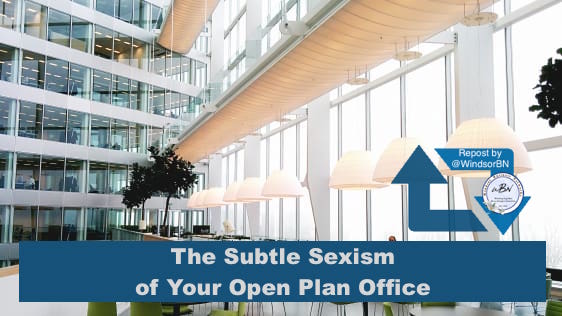
There are many reasons to hate open offices: They’re loud, prone to thieves, and, most of all, lack any kind of privacy. But a new research paper reveals yet another knock against them: They’re subtly sexist.
Researchers Alison Hirst of Anglia Ruskin University and Christina Schwabenland of the University of Bedfordshire studied the process of a local government moving its 1,100 employees from a series of traditional offices to one big open office over the course of three years in the U.K. The new office had all the markings of a typical open plan office–glass everywhere, identical desks for everyone, and collaborative group spaces–and was designed with the intention of breaking down hierarchies and encouraging employees to engage with each other more. As the researchers wrote in their paper, which was published in published in Gender, Work and Organization, “it was designed to enchant rather than control overtly, and to encourage movement rather than fixity.”
To understand how people adjusted to the new office, Hirst interviewed 27 women and 13 men for one to two hours over the course of three years, with two intensive periods of observation and interviews and many other visits. Besides interviews, Hirst also participated in some of the office’s culture, having lunch and informal coffee breaks with employees and attending meetings. While some female employees felt like the new office space promoted equality, others had the opposite reaction. The researchers found that many women became hyper-aware of being constantly watched and their appearance constantly evaluated; multiple women told them that “there isn’t anywhere that you don’t feel watched.” Of the men Hirst interviewed, there was no evidence they felt similarly or changed their actions as a result of the lack of privacy.
The architect of the new office, who was kept anonymous, anticipated that people might feel uncomfortable with the heavily glass office at first, but in interviews with the researchers, he said he thought people would get used to it. “I think it’s like going to a nudist beach. You know, first you’re a little bit worried that everyone’s looking at you, but then you think, hang on, everybody else is naked, no one’s looking at each other,” he told the researchers. “I think that’s what’ll happen, they’ll get on with it.”
The only problem is that sociological research of nudist beaches has shown that people do continue to watch each other–“men in particular, often in groups, look obsessively at women,” the researchers write. This kind of all-glass, no-privacy environment leads to a subtle kind of sexism, where women are always being watched and thus judged on their appearances, causing anxiety for many employees. One woman named Pat told the researchers that the men on her team used to “mark” the attractiveness of young women coming into the office for interviews. “Visibility enabled these men to judge and rank women according to their sexual attractiveness, just like men on the nudist beaches,” the researchers write.
Some women would avoid visiting parts of the office where they weren’t expected: “You just don’t, do you? Right, this is going to sound extremely sexist but remember I do work with a lot of men,” a woman named Wendy told the researchers. “If you were a female, that would definitely get a comment from all the men because they would notice you.” For Wendy, the design of the office, despite the architects’ intention of promoting freedom of movement, actually inhibited it.
Conscious of male eyes, some women began to dress differently. Without an architectural layout that indicated their place in the office hierarchy, they began to rely on their clothing to signal to other people whether they were important or not. One woman told the researchers that she started wearing jackets and stopped wearing cardigans because the latter would indicate that she was in admin. Others began to wear more makeup or dress up more, conscious that people were looking at them all the time.
Fascinatingly, the study did not start out as an examination of gender specifically–it was meant as an examination of how workplace culture shifts when office design changes radically. It was only when Hirst, who conducted interviews on-site and spent a lot of time observing the workplace, began to feel pressure to dress in a more feminine way herself that she began to wonder about it. “She was surprised by the unusual amount of care she took over her own appearance, a degree of self-consciousness that she found burdensome as time progressed,” the researchers write. “To ‘fit in’ with the modern, clean aesthetic of the building itself and a dress code that was widely adopted, she departed from her usual preference for wearing jeans and no makeup; adopting a smart trouser suit and putting on makeup.”
Not only were women’s physical appearances up for judging, the open office also meant there was no private space where workers could go if they were emotionally distressed or needed to conduct a private conversation. “If you’re upset about something, there’s nowhere to go,” one woman told the researchers. “Where can you go? All you can do is go to the ladies, so there’s nowhere that you can go and speak to somebody on a one-to-one basis where you can’t be observed.”
The uniformity of the spaces had another effect on one woman who was going through menopause–she felt like she couldn’t have a fan on her desk to help with hot flashes because everyone would have noticed: “I just have to sort of work through it,” she told the researchers.
Perhaps it’s no coincidence that all the designers of the workspace were men. Would the design have been different if there were any women on the team? Are the experiences of these women limited to this particular open-office design, or do others suffer the same kind of anxiety? We want to hear from you. To share your experience, either as a designer or as an occupant, email CoDTips@fastcompany.com.
/May 7, 2018
View on fastcodesign.com
